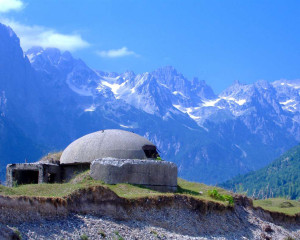By Donna Welles.

An old communist bunker overlooking the spectacular peaks of Valbona Valley. An estimated 700.000 concrete bunkers were built by Hoxha’s regime.
During the twentieth century, southeastern Europe was dominated by three strong dictators; these were Enver Hoxha of Albania, Nicolae Ceaușescu of Romania, and Josip Broz Tito of Yugoslavia. All three men have since died. What has replaced these leaders? Allow us to examine modern Albania by way of its social and economic indicators.
Albania’s armed forces pool has dropped by 90% since 1995. In 1995, Albania had 86,500 soldiers and in 2013 Albania had 8,500 soldiers. Romania has retained 151,300 soldiers. Yugoslavia has been separated politically into six nation-states, including Bosnia, Croatia, Macedonia, Montenegro, Serbia, and Slovenia.
Albania’s GDP has grown from $4 billion in 2000 to $13 billion in 2014. Italy and the People’s Republic of China are Albania’s major trading partners in terms of both imports and exports. Romania’s GDP has grown from $37 billion in 2000 to $199 billion in 2014. Germany and Italy are Romania’s major trading partners in terms of both imports and exports.
Population figures for both Albania and Romania have dropped since 2000. Albania currently has 2.9 million people; Romania has 19.9 million people. In 2000, Albania had 3.1 million and Romania had 22.4 million.
Albania last reported unemployment figures in 2012 when it was 13.4%; Romania reported in 2013 when it was 7.3%. Albania reported an unemployment rate of 22.7% in 2001, 13.5% in 2007, and 14.2% in 2010. Romanian unemployment rates have not risen above their 2002 report which was 8.1%.
Trade balance is an issue for Albania as Albanian exports totaled $2.3 billion in 2013 and imports totaled $4.8 billion. Exports from Albania are largely mineral fuel, clothing apparel, and iron and steel. Imports to Albania include 22% manufactured goods, 18% machinery, 17% mineral fuel, and 13% agricultural products.
Albania’s life expectancy is 78 years and it has a similar land area to that of the State of Maryland.


